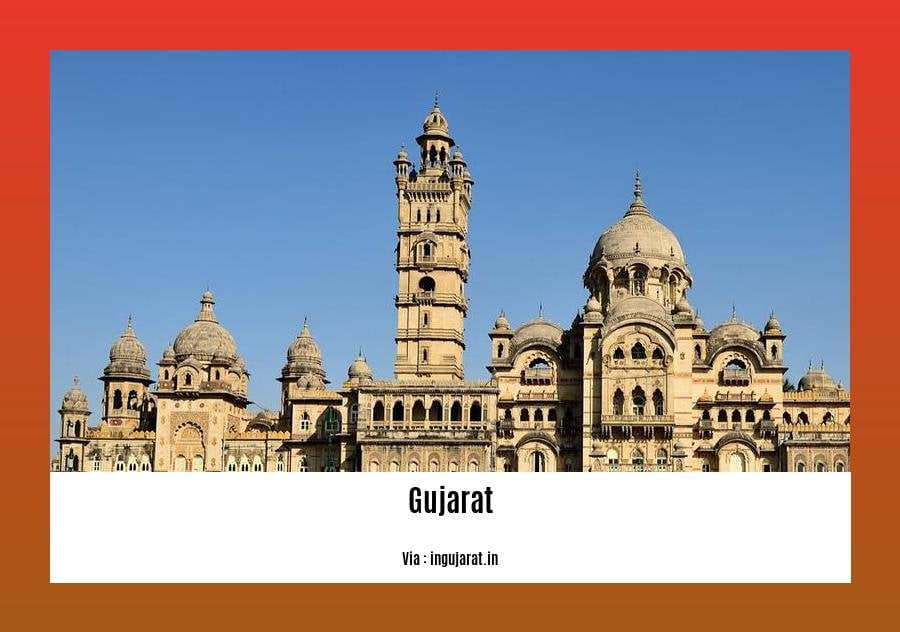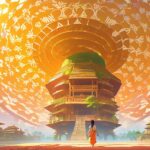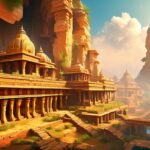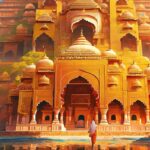Gujarat, a vibrant and captivating region in India, is home to a wealth of fascinating facts that shed light on its rich history, diverse culture, and thriving economy. In this article titled “Facts About Gujarat: Exploring the Rich History, Culture, and Economics of the Region,” we will delve into the intriguing facets of Gujarat and uncover the hidden gems that make this state truly unique. From its ancient archaeological sites to its bustling industries, join us on a journey to discover the captivating facts that define Gujarat’s essence.
Key Takeaways:
- Gujarat is the fifth-largest state in India by area and the ninth-largest by population.
- It has the longest coastline of any Indian state, stretching over 1600 km.
- Gujarat is a highly industrially developed state and a manufacturing hub.
- The state is home to significant ancient sites of the Indus Valley Civilisation.
- The name “Gujarat” comes from Sanskrit, meaning the land of the Gurjars, an ancient tribe.
- Gujarat boasts the world’s tallest statue, the Statue of Unity, and the largest cricket stadium, the Narendra Modi Stadium.
- Ahmedabad is the largest city and Gandhinagar is the capital of Gujarat.
- The state has 23 wildlife sanctuaries and four national parks.
- Gujarat ranks 21st in India’s human development index and is known for its industrial development and low unemployment.
- Gujarat has the longest coastline in India and the largest district in the country.
Facts About Gujarat: Exploring the Rich History, Culture, and Economics of the Region

Gujarat, the vibrant western state of India, is a land that holds a multitude of fascinating facts. From its ancient heritage to its modern achievements, Gujarat is a region that captivates with its rich history, diverse culture, and thriving economy. Let’s delve into some remarkable facts about Gujarat, shedding light on its unique characteristics.
A Land of Heritage and Civilization
Gujarat proudly preserves the remnants of the mighty Indus Valley Civilization, reminding us of its ancient lineage. Explore the well-preserved archaeological sites at Lothal, Dholavira, and Gola Dhoro, and immerse yourself in the marvels of this ancient civilization.
Coastline Splendor
Stretching over an impressive 1600 kilometers, Gujarat boasts the longest coastline of any Indian state. Endowed with beautiful beaches, picturesque fishing villages, and bustling ports, the coastal areas of Gujarat offer a glimpse into a vibrant maritime culture that has thrived for centuries.
Industrial Powerhouse
Gujarat stands as a shining example of India’s industrial development. It is renowned as a manufacturing hub with a robust industrial infrastructure. Various industries ranging from textiles and chemicals to pharmaceuticals and automobiles flourish in this industrious state, contributing significantly to the Indian economy.
Etymology and Identity
The name “Gujarat” finds its roots in ancient history. Derived from Sanskrit, the term refers to the land of the Gurjars, an ancient tribe that once inhabited this region. This etymology adds charm to the state’s identity, connecting it with a rich cultural heritage.
Monuments of Grandeur
Gujarat is home to magnificent architectural wonders that leave visitors in awe. Witness the grandeur of the Statue of Unity, the world’s tallest statue, paying homage to India’s visionary statesman, Sardar Vallabhbhai Patel. And don’t miss the Narendra Modi Stadium, the largest cricket stadium globally, where cricketing history has been created.
Historic Capitals and Vibrant Cities
Ahmedabad, the bustling metropolis, serves as Gujarat’s largest city, pulsating with energy and cultural vibrancy. Gandhinagar, the capital, stands as a testament to modern urban planning with its well-organized streets and meticulously designed cityscape. Together, they represent the blend of history and progress that defines Gujarat.
Nature’s Abode
Gujarat’s natural landscapes are a treat for nature enthusiasts. With 23 wildlife sanctuaries and four national parks, including Gir Forest National Park, the last abode of the Asiatic Lion, Gujarat offers a sanctuary for a diverse range of flora and fauna, making it a paradise for wildlife lovers.
Human Development and Prosperity
Ranked 21st in the human development index among Indian states, Gujarat stands proud as an industrially developed region with low unemployment rates. The state’s commitment to economic growth and social development has propelled it towards prosperity, fostering a better quality of life for its residents.
As we explore these facts about Gujarat, we uncover a tapestry of heritage, progress, and natural splendor. This land invites you to delve deeper, to discover its hidden treasures, and to embrace the spirit of Gujarat that resonates throughout its diverse communities.
Did you know that the strand of study called STEM encompasses science, technology, engineering, and mathematics? If you’re curious about the facts about the STEM strand, click here to learn more!
Are you a fan of family trivia? Discover fascinating facts about family dynamics and traditions by clicking here.
If you love football and want to uncover interesting insights about Liverpool, the iconic city in England, click here to explore some surprising facts!
Have you ever wondered what it takes to become a veterinarian? Find out intriguing facts about veterinarians and their remarkable work by clicking here.
Cultural Diversity in Gujarat

As we delve into the fascinating world of Gujarat, we uncover a tapestry of cultural diversity that has shaped this vibrant region in western India. Gujarat’s cultural mosaic is composed of the influences of Hinduism, Islam, Jainism, and Buddhism, resulting in a rich blend of beliefs, customs, traditions, institutions, and practices.
Gujarat is known for its balanced lifestyle and acceptance of different religious beliefs. It embraces cultural diversity, fostering an environment where people from different faiths coexist harmoniously. This inclusive approach is deeply rooted in the state’s ethos and is reflected in various aspects of Gujarati culture.
Gol Dhana: One unique aspect of Gujarati culture is the engagement ceremony, known as “Gol Dhana.” Unlike the traditional ring ceremony seen in many other cultures, Gol Dhana focuses on purity and simplicity, with the exchange of gifts that symbolize blessings and well-wishes for the couple.
Cuisine: When exploring cultural diversity in Gujarat, one cannot overlook the culinary delights that exemplify the region’s rich heritage. Gujarati cuisine is known for its traditional and authentic flavors, offering a wide variety of vegetarian dishes. From the savory flavors of dhokla and fafda to the sweetness of shrikhand and jalebi, the Gujarati platter is a culinary adventure that caters to all palates.
Fairs and Festivals: The fairs and festivals of Gujarat are a vibrant and integral part of its cultural heritage. From the grand celebrations of Navratri, where people gather to dance the Garba and Dandiya Raas, to the colorful and exuberant kite festival of Uttarayan, Gujarat’s calendar is filled with joyous occasions that showcase the state’s cultural diversity and zest for life.
Music, Dance, and Cinema: Gujarat has a rich tradition of music and dance, with traditional forms like Garba and Dandiya Raas being popular not only during festivals but also as a means of socializing and celebration. The state is also home to a vibrant cinema industry, with Gujarati films produced and enjoyed by the local population, further contributing to the cultural fabric of Gujarat.
In conclusion, Gujarat’s cultural diversity is a tapestry woven from the threads of Hinduism, Islam, Jainism, and Buddhism. This rich heritage is reflected in the state’s beliefs, customs, traditions, institutions, and practices. Celebrated through engagement ceremonies like Gol Dhana, flavorsome cuisine, vibrant fairs and festivals, and captivating music, dance, and cinema, cultural diversity thrives in Gujarat, making it a truly remarkable region.
Key Takeaways:
- Gujarat embraces cultural diversity, fostering an environment where people from different faiths coexist harmoniously.
- The engagement ceremony in Gujarat, known as “Gol Dhana,” focuses on purity and simplicity.
- Gujarati cuisine offers a wide variety of vegetarian dishes with traditional and authentic flavors.
- The fairs and festivals of Gujarat are a vibrant and integral part of its cultural heritage.
- Gujarat has a rich tradition of music and dance, with Garba and Dandiya Raas being popular forms.
- The state boasts a vibrant cinema industry producing Gujarati films enjoyed by the local population.
Sources:
1. Culture of Gujarat | 8 Things about the Vibrant Gujarat
2. Culture of Gujarat, Traditions, Food, Festival
Economic Growth and Industries in Gujarat
Gujarat’s economic growth is fueled by its diverse sectors, including services, manufacturing and industry, and agriculture. The state government’s initiatives have played a crucial role in promoting economic development. However, there is a need for more inclusive growth to address disparities in social sectors.
Services Sector:
- Services account for around 37% of Gujarat’s economy, setting it apart as a large economy with low dependence on services.
- Gujarat is home to thriving sectors such as finance, IT, telecommunications, tourism, and healthcare, contributing significantly to its economic growth.
- The state offers a favorable business environment, attracting national and international investments in the services sector.
Manufacturing and Industry:
- Gujarat is considered one of the best hubs for industry, with a robust industrial infrastructure.
- The state is known for its manufacturing prowess in sectors such as textiles, chemicals, petrochemicals, pharmaceuticals, automobiles, and engineering.
- Gujarat’s strategic location, excellent connectivity, and investor-friendly policies have attracted numerous industries and facilitated economic growth.
Agriculture:
- Agriculture plays a crucial role in Gujarat’s economy, providing basic incentives and contributing to overall growth.
- The state is known for major agricultural produce such as cotton, groundnuts, dates, sugar cane, milk, and milk products.
- Gujarat’s agriculture sector benefits from innovative practices, advanced irrigation techniques, and government support for farmers.
Government Initiatives:
- The Gujarat government has taken several initiatives to promote economic development in the state.
- These initiatives include policies to attract investments, improve infrastructure, facilitate ease of doing business, and promote entrepreneurship.
- The government’s efforts have resulted in Gujarat being considered one of the high-growth states in India.
Challenges and Social Development:
- Despite its economic success, Gujarat faces challenges in social development.
- Reports suggest that the state lags behind in improvements in social sectors like health and education.
- Inclusive development is necessary to ensure that all social groups and regions benefit equally from economic growth.
Key Takeaways:
- Gujarat’s economy is diverse, with sectors like services, manufacturing and industry, and agriculture driving its economic growth.
- The state government’s initiatives have played a significant role in attracting investments and promoting economic development.
- Gujarat faces challenges in social development and needs to focus on inclusive growth to address disparities in social sectors.
Sources:
- inGujarat.in. “Gujarat Economy: Sectors Driving Growth.” Retrieved from source.
- SpringerLink. “Inclusive Development: A Case Study of Gujarat.” Retrieved from source.
Tourist Attractions in Gujarat
Gujarat, located in western India, is a vibrant state with a rich history, diverse culture, and stunning natural beauty. Exploring the tourist attractions in Gujarat is a perfect way to immerse yourself in its unique charm. From majestic statues to ancient cities and wildlife sanctuaries, Gujarat offers a plethora of experiences for travelers. Let’s dive into some of the must-visit attractions:
Statue Of Unity:
The Statue of Unity is a remarkable tourist destination in Gujarat and holds the title of being the world’s tallest statue. Dedicated to Indian political leader and freedom fighter, Sardar Vallabhbhai Patel, this iconic statue offers panoramic views of the surrounding area from its observation deck. It is a symbol of unity, strength, and national pride.
Junagadh:
Junagadh, meaning “old palace,” is a city steeped in history, dating back to ancient times. It boasts several historical sites, including the impressive Uparkot Fort, the mesmerizing Mahabat Maqbara, and the enlightening Junagadh Museum. Exploring these sites will transport you back in time and unravel the intriguing stories of the past.
Ahmedabad:
Ahmedabad, the largest city in Gujarat, is a perfect blend of modernity and history. It is renowned for its cultural heritage, showcased in iconic structures like the peaceful Sabarmati Ashram, the magnificent Jama Masjid, and the exquisite Sidi Saiyyed Mosque. Strolling through the vibrant streets of Ahmedabad will give you a glimpse into the rich tapestry of Gujarat’s past and present.
Baroda:
Baroda, also known as Vadodara, is a popular tourist destination in Gujarat. It is famous for its regal palaces, including the enchanting Laxmi Vilas Palace and the captivating Maharaja Fateh Singh Museum. The city also offers beautiful gardens and art galleries, providing a delightful blend of history, art, and nature.
Sasan Gir National Park:
For wildlife enthusiasts, a visit to Sasan Gir National Park is a must. It is the only place in the world where the Asiatic lion can be found in its natural habitat. Embark on a thrilling Jeep safari to catch a glimpse of these majestic creatures, along with other wildlife, such as leopards and various bird species.
Rani Ka Vav:
Rani Ka Vav, also known as the Queen’s Stepwell, is a UNESCO World Heritage Site located in Patan. It is a testament to the exquisite stepwell architecture and showcases stunning sculptures depicting ancient tales. History and architecture lovers will be enthralled by the intricate beauty of Rani Ka Vav.
Dwarkadhish Temple:
Dwarkadhish Temple, located in Dwarka, is one of the Char Dham pilgrimage sites in India. Dedicated to Lord Krishna, it attracts devotees from all over the country. This ancient temple holds immense religious significance and is believed to be one of the seven ancient cities of India.
These are just a few of the many tourist attractions in Gujarat that offer a glimpse into its rich history, culture, and natural beauty. Exploring these sites will leave you with a deeper understanding of Gujarat’s heritage and its captivating allure.
Key Takeaways:
– Gujarat offers a wide range of tourist attractions, from the world’s tallest statue, the Statue of Unity, to ancient cities like Junagadh.
– The city of Ahmedabad showcases a blend of modernity and history, with cultural landmarks like the Sabarmati Ashram and the Jama Masjid.
– Baroda is known for its regal palaces, including the Laxmi Vilas Palace, while Sasan Gir National Park is a haven for wildlife enthusiasts.
– The UNESCO World Heritage Site, Rani Ka Vav, exhibits stunning stepwell architecture, and the Dwarkadhish Temple holds immense religious significance.
– Exploring these attractions provides a deeper understanding of Gujarat’s rich heritage and natural beauty.
Sources:
– SOTC – Amazing Tourist Places to Visit in Gujarat
– TripSavvy – Top Attractions and Places in Gujarat
FAQ
Q1: What is the significance of the Statue of Unity in Gujarat?
A1: The Statue of Unity in Gujarat is the tallest statue in the world and is dedicated to Indian political leader Sardar Vallabhbhai Patel. It is a prominent tourist attraction that offers panoramic views of the surrounding area from its observation deck.
Q2: What are some historical sites to visit in Gujarat?
A2: Gujarat is home to several historical sites, including the Uparkot Fort and Mahabat Maqbara in Junagadh, the Sabarmati Ashram and Jama Masjid in Ahmedabad, and the Laxmi Vilas Palace and Maharaja Fateh Singh Museum in Baroda.
Q3: Where can I see Asiatic lions in their natural habitat?
A3: The Sasan Gir National Park in Gujarat is the only place in the world where the Asiatic lion can be found in its natural habitat. Wildlife enthusiasts can enjoy Jeep safaris to spot lions, leopards, and various bird species.
Q4: What is Rani Ka Vav and why is it famous?
A4: Rani Ka Vav, also known as the Queen’s Stepwell, is a UNESCO World Heritage Site located in Patan. It showcases intricate stepwell architecture and beautiful sculptures, making it a popular attraction for history and architecture lovers.
Q5: What is the significance of Dwarkadhish Temple in Gujarat?
A5: Dwarkadhish Temple in Dwarka is one of the Char Dham pilgrimage sites in India and is dedicated to Lord Krishna. It attracts devotees from all over the country and is believed to be one of the seven ancient cities of India.
- Unlocking Francis Alexander Shields’ Finance Empire: A Comprehensive Biography - July 12, 2025
- Unveiling Francis Alexander Shields: A Business Legacy - July 12, 2025
- Francis Alexander Shields’ Business Career: A Comprehensive Overview - July 12, 2025















